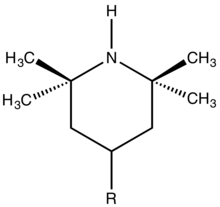Hindered amine light stabilizers

Hindered amine light stabilizers (HALS) are chemical compounds containing an amine functional group that are used as stabilizer]]s. The protect dyes and pigments in paints from light-induced polymer degradation.[1]
Hindered amine light stabilizers are usually derivatives of 2,2,6,6-tetramethylpiperidine. These compounds are extremely efficient stabilizers against light-induced degradation of most polymers.[2]
HALS do not absorb UV radiation, but act to inhibit degradation of the polymer. They slow the photochemically initiated degradation reactions, to some extent in a similar way to antioxidants.
One advantage of the hindered amine light stabilizers is that no specific layer thickness or concentration limit needs to be reached to guarantee good results. Significant levels of stabilization are achieved at relatively low concentrations. HALS's high efficiency and longevity are due to a cyclic process wherein the HALS are regenerated rather than consumed during the stabilization process. These advantages result in an expected considerable increase of demand for HALS, especially in products made from polypropylene and polyethylene. The mechanism of hindered amines stabilizers against thermooxidation appears to be complex. Because of the regenerative nature of this process, as well as the typically high molecular weights of the stabilizers, hindered amine stabilizers are capable of providing extreme long-term thermal and light stability.
What tends to be important for the choice of the light stabilization system is the chemical nature of the polymers used and tackifier resins, as described in the next pages. Interaction has also been observed with fillers and pigments.
Mechanism of action
A number of different reactions are responsible for the stabilizing effect they have on photooxidation. Proof has been found of the radical entrapment qualities of carbon radicals, the reaction of HALS metabolites with peroxy radicals and the decomposition of hydroperoxides.
An acidified hindered amine cannot easily enter into the free radical scavenging cycle.
N-H and N-R hindered Amine Stabilizers fit most needs regarding light stability but can be alkaline.
N-OR type enter the UV stabilization cycle quickly and are much less alkaline than N-H or N-R type of HALS.
References
- ↑ Pieter Gijsman (2010). "Photostabilisation of Polymer Materials". In Norman S. Allen. Photochemistry and Photophysics of Polymer Materials Photochemistry. Hoboken: John Wiley & Sons. doi:10.1002/9780470594179.ch17..
- ↑ Klaus Köhler; Peter Simmendinger; Wolfgang Roelle; Wilfried Scholz; Andreas Valet; Mario Slongo (2010). "Paints and Coatings, 4. Pigments, Extenders, and Additives". Ullmann's Encyclopedia Of Industrial Chemistry. doi:10.1002/14356007.o18_o03.